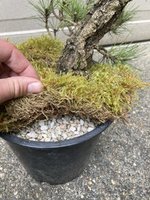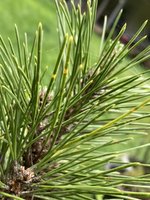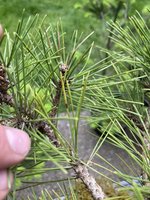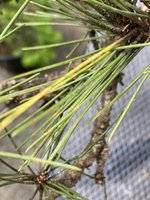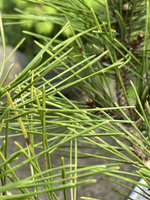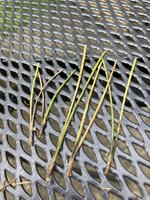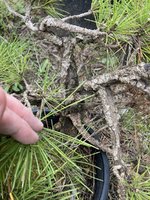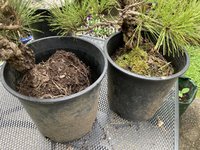Cruiser
Chumono
This is the first jbp I’ve purchased. I couldn’t say no to that bark. It reminds me of pitch pines in the sand dunes of Cape Cod. Gnarly and weathered, like salty old sailors.
The cultivar is Nishiki tsukama. It’s 15 years old. It’s been in this plastic pot for 5 years. Aside from preexisting fertilizer balls in the soil, no additional nutrients have been given.
The substrate appears to be basic potting soil. It is coated in a white fuzz, which I hope is mycorrhizal. The roots look ok but are pot bound.
Judging from the candles, the tree does not seem vigorous. It doesn’t seem unhealthy either. I’m chocking it up to being positioned in partial shade and never getting fed, but maybe it’s something else.
I’ve done some homework but realize that there’s a lot to learn and have questions.
-Given that the tree is root bound, would it make sense to gently put it into a larger container at this time? (Not mess with the roots). Or should I give it some fertilizer and wait for a proper repot next year?
-Would it be okay to wire a new leader into place at this time (while the branches are still flexible).
-Should I use liquid fertilizer to catch up on growth this year or sprinkle on some organic-granular?
If anyone has additional advice or tips they’d like to share, I’m all ears.
The cultivar is Nishiki tsukama. It’s 15 years old. It’s been in this plastic pot for 5 years. Aside from preexisting fertilizer balls in the soil, no additional nutrients have been given.
The substrate appears to be basic potting soil. It is coated in a white fuzz, which I hope is mycorrhizal. The roots look ok but are pot bound.
Judging from the candles, the tree does not seem vigorous. It doesn’t seem unhealthy either. I’m chocking it up to being positioned in partial shade and never getting fed, but maybe it’s something else.
I’ve done some homework but realize that there’s a lot to learn and have questions.
-Given that the tree is root bound, would it make sense to gently put it into a larger container at this time? (Not mess with the roots). Or should I give it some fertilizer and wait for a proper repot next year?
-Would it be okay to wire a new leader into place at this time (while the branches are still flexible).
-Should I use liquid fertilizer to catch up on growth this year or sprinkle on some organic-granular?
If anyone has additional advice or tips they’d like to share, I’m all ears.
Attachments
-
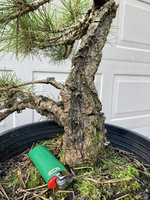 FD048A80-CFDA-47E5-BD4B-BFC31D2C55D4.jpeg294.3 KB · Views: 444
FD048A80-CFDA-47E5-BD4B-BFC31D2C55D4.jpeg294.3 KB · Views: 444 -
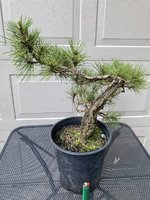 72C75096-3721-4B4B-97DD-F9FEFC19AC9C.jpeg364.9 KB · Views: 391
72C75096-3721-4B4B-97DD-F9FEFC19AC9C.jpeg364.9 KB · Views: 391 -
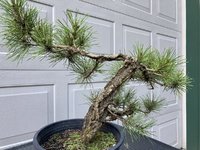 43A32D1D-5D06-44E9-B91E-B442E95D145F.jpeg304 KB · Views: 347
43A32D1D-5D06-44E9-B91E-B442E95D145F.jpeg304 KB · Views: 347 -
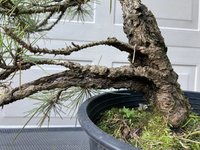 141E8339-9B25-41F4-87C9-24573424B17B.jpeg264.3 KB · Views: 302
141E8339-9B25-41F4-87C9-24573424B17B.jpeg264.3 KB · Views: 302 -
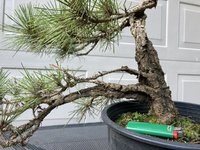 16EEB67D-B577-4F9D-AE06-E8A3AD00E592.jpeg294.9 KB · Views: 298
16EEB67D-B577-4F9D-AE06-E8A3AD00E592.jpeg294.9 KB · Views: 298 -
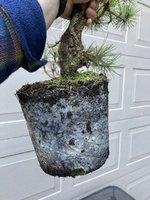 0F5EBE78-0327-4401-96AB-0AE7DC99BC2B.jpeg231.1 KB · Views: 288
0F5EBE78-0327-4401-96AB-0AE7DC99BC2B.jpeg231.1 KB · Views: 288 -
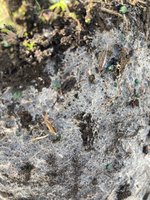 BFFD486B-D248-4BA8-B6EA-0B64F6213C7E.jpeg311 KB · Views: 264
BFFD486B-D248-4BA8-B6EA-0B64F6213C7E.jpeg311 KB · Views: 264 -
 A01547F3-2F99-40E2-8FA7-29171BA7921C.jpeg134.2 KB · Views: 264
A01547F3-2F99-40E2-8FA7-29171BA7921C.jpeg134.2 KB · Views: 264




